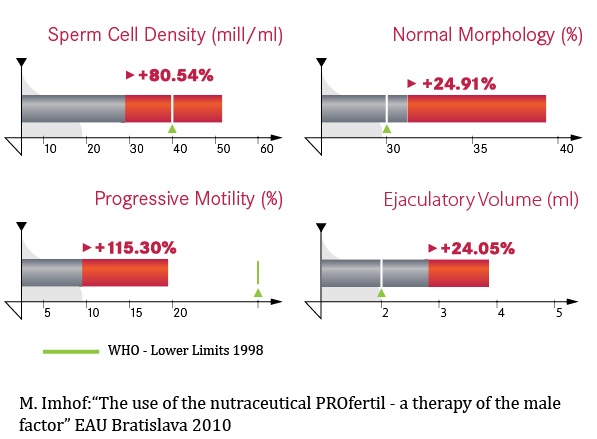“The use of the nutraceutical PROfertil ® – a therapy of the male factor”
Pilot Study 2006 – 2008
The search for alternative treatment approaches to improve sperm quality
With a rapid increase of abnormal semen analyses in recent years and no established treatment for the improvement of sperm quality available, there is a rising awareness of alternative treatment approaches such as dietary treatment with micronutrients.
Study design
A total of 120 men with an average age of 35.9 (ages 23-58) with long-term infertility (>2 years) and at least two abnormal semen analyses in the history were included in this pilot study at the Fertility Centre at the International Medical Clinic in Vienna (Austria). Patients with azoospermia, aspermia, known varicocele and urogenital infections were excluded from the study. PROfertil ® was given as part of a calculated diet for three months, one capsule twice daily. A follow-up semen analysis was carried out at the end of the three month period.
Is the whole really greater than the sum of its parts?
The aim of this study was to examine a combination of eight scientifically substantiated individual substances and their impact on sperm quality. The hypothesis was that the effect of all individual substances together would have an additive effect.
Study results in detail
The use of PROfertil® for the treatment of the male factor and improvement of the sperm count1) was successful: The sperm cell density increased on average from 29.46 million/ml to 53.19 million/ml (+ 80.54%), with an average 23.73 million increase in sperm density per millilitre. The ejaculate volume increased from 2.91 ml on 3.61 ml (+ 24.05%). The number of progressively motile sperm increased from 8.95% to 19.27% (+115.3%) on average. Total motility (excluding static sperm) showed a cumulative increase from 33.13% to 49.27% (+ 48.71%). The number of sperm with normal morphology improved from 31.14% to 38.90% (+24.91%).
Conclusion
30 of 120 subjects achieved a normal sperm count without any abnormalities. To date, there are 21 pregnancies known to have occurred during this study. These results confirm the hypothesis that the combination of individual substances as described in literature shows significantly better results than the sum of the effects of single administration.

